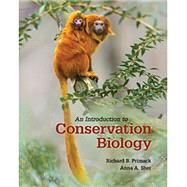New coauthor Anna Sher joins longtime author Richard Primack in creating a book that combines the readability of Primack's A Primer of Conservation Biology with the depth and coverage of his larger textbook, Essentials of Conservation Biology. The result is a book well suited for a wide range of undergraduate courses, as both a primary text for conservation biology courses and a supplement for ecological and environmental science courses.
Using the chapter framework of the current Primer as a springboard, the authors have added three chapters focused on population biology conservation tools (Chapter 7), restoration ecology (Chapter 10), and the future of conservation (Chapter 12). Sustainable development, ex situ conservation, and other key topics have been expanded and updated with hundreds of new examples, explanations, citations, and figures to enhance learning and excitement for the subject. Mining her experience teaching conservation biology with Dr. Primack's texts for over a decade, Dr. Sher fine-tunes the presentation of difficult concepts, particularly in economics and politics. Coverage of recent conservation biology events in the news--such as the poaching of Cecil the lion, the first papal encyclical on the environment, and the international Paris Accord on climate change--keeps the content fresh and current.
The book's twelve chapters (see Contents) focus successively on biological diversity and its value; threats to biological diversity; conservation at the population and species levels; protecting, managing and restoring ecosystems; and sustainable development. Each chapter begins with general ideas and principles, beautifully illustrated in full color with diverse examples from the current literature. Chapters end with summaries, an annotated list of suggested readings, discussion questions, and extensive summary statements in the text margins, as study aids. Throughout, the authors maintain a focus on the active role that scientists, local people, conservation organizations, government, and the general public play in protecting biodiversity, even while providing for human needs.
RESOURCES
For Instructors
Instructor's Resource Library
This resource includes all figures (line-art illustrations and photographs) and tables from the textbook, provided as both high- and low-resolution JPEGs. All have been formatted and optimized for excellent projection quality. Also included are ready-to-use PowerPoint slides of all figures and tables.








